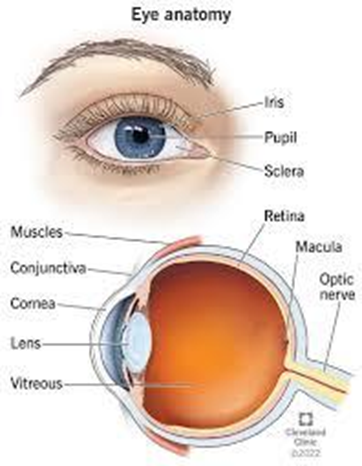Which of the following functions is associated with skeletal muscle?
Forming the contractile component of the digestive urinary, and reproductive systems
Contracting to cause involuntary muscle movements
Pumping blood throughout the body
Shivering for heat production
The Correct Answer is D
a. Forming the contractile component of the digestive, urinary, and reproductive systems: This describes smooth muscle, not skeletal muscle.
b. Contracting to cause involuntary muscle movements: This is a characteristic of smooth and cardiac muscles. Skeletal muscle is primarily involved in voluntary movements.
c. Pumping blood throughout the body: This is the function of cardiac muscle, not skeletal muscle.
d. Shivering for heat production: Correct. Skeletal muscles generate heat through shivering, which is an involuntary contraction response to cold.
Nursing Test Bank
Naxlex Comprehensive Predictor Exams
Related Questions
Correct Answer is B
Explanation
a: Is the colored part of the eye - This describes the iris, which is the colored part of the eye that regulates the size of the pupil.
b. Located in the posterior cavity: The retina is a layer of tissue located in the posterior cavity of the eye. It contains photoreceptor cells that convert light into neural signals, which are then transmitted to the brain via the optic nerve.

c: Is the outermost layer of the eye - The outermost layer of the eye is the sclera, a tough, white layer that helps maintain the shape of the eye.
d: Produces aqueous humor - Aqueous humor is produced by the ciliary body and is found in the anterior chamber of the eye, not in the retina.
Correct Answer is D
Explanation
a. Decrease in sodium reabsorption: This would lead to further lowering of blood pressure, which is not a compensatory response.
b. Dilation of the afferent arteriole: This typically increases glomerular filtration rate but is not a primary response to decreased blood pressure.
c. Constriction of the efferent arteriole: This response helps to increase glomerular pressure but is secondary to other mechanisms.
d. Release of renin: Renin is released by the kidneys in response to low blood pressure, initiating the renin-angiotensin-aldosterone system (RAAS) to increase blood pressure by conserving sodium and water and constricting blood vessels.
Whether you are a student looking to ace your exams or a practicing nurse seeking to enhance your expertise , our nursing education contents will empower you with the confidence and competence to make a difference in the lives of patients and become a respected leader in the healthcare field.
Visit Naxlex, invest in your future and unlock endless possibilities with our unparalleled nursing education contents today
Report Wrong Answer on the Current Question
Do you disagree with the answer? If yes, what is your expected answer? Explain.
Kindly be descriptive with the issue you are facing.
